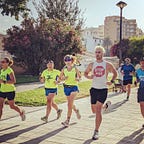The Miracle in ‘The Feeding of the 5,000’ Isn’t What You Think
After hearing of John the Baptist’s death, Jesus retreated to a remote spot along the north shore of the Sea of Galilee to pray (Matthew 14:13). Word spread of his whereabouts, and a crowd of 5,000 formed around him. Instead of sending them away or moving, Jesus “began to teach them many things” (Mark 6:34) and continued until late in the day.
So begins “The Feeding of the 5,000,” the only miracle that appears in all four gospels (a similar story, in which there are 4,000 hungry followers, also appears in Matthew and Mark). It’s one of the better-known gospel stories, but I can’t help feeling like we missed something.
When Jesus was finished preaching, the disciples asked him to dismiss the crowd. It was late, and the people were hungry. The disciples had not anticipated the crowd’s size or arranged for everyone to be fed. It would be too expensive to buy food for all of them.
“Send them away,” they said, “so that they may go into the surrounding country and villages and buy something for themselves to eat” (Mark 6:36).
Many of these people had traveled long distances to hear Christ’s teachings, and the roads were dangerous at night.
Jesus responded sharply, telling them instead, “You give them something to eat” (Mark 6:37).
“Send them away,” they said, “so that they may go into the surrounding country and villages and buy something for themselves to eat” (Mark 6:36).
The disciples took inventory of what they had, but they could only collect five loaves of bread and two fish from a boy in the crowd (John 6:9). Nonetheless, Jesus took the food, gave thanks, and had it distributed.
We are told that after the crowd was fed and had dispersed, the disciples picked up twelve baskets of fragments (Matthew 14:20) — the Feeding of the 5,000.
But when did the miracle occur? In masses and Sunday schools, we are told of the supernatural power of Christ, that somehow He could multiply the food as it traveled through the hungry crowd in yet another example of Christ’s divine power.
That’s not good enough. The miracle lacks purpose and depth. No one is doubting Jesus’ divinity. No one is asking for proof of His power. They are all just hungry.
One part of the story sticks out to me: Jesus says, “You give them something to eat,” and a boy from the crowd gives away his bread and fish to the disciples.
You give them something to eat, He said.
He isn’t talking to the disciples. He’s talking to everyone. The boy in the crowd listens, inspired by the teachings of Christ to share what he has, and afterward Jesus gives thanks.
Let’s imagine that, in addition to thanking God, Jesus thanks the boy. He expresses gratitude for the selfless act of giving up his own food. He was the only one willing to share what he had for the strangers around him, even though he knew it could not feed that many people. Jesus preached until late in the day, and for at least one person, those lessons were received.
Yet by thanking the boy in front of the hungry crowd, Jesus acknowledges this small act of charity, and somehow his modest gift is enough to feed an enormous crowd. That, to me at least, makes the miracle the inspiration of charity, one of the cornerstones of Jesus’ work as well as the Church itself. By giving thanks, by acknowledging the generosity of a single person, an entire crowd was fed.
Jesus inspired the boy, and the boy inspired the crowd. Following this act of love, the people were moved to share what they had, even if it wasn’t much, even if it was just something for the road, and because of their generosity, everyone got to eat.
This is the real miracle of “The Feeding of the 5,000,” the one we ought to pay more attention to.
These literal miracles have symbolic value. The first example is symbol of the promise of happiness. The second foreshadows the coming resurrection of the dead. The third, most pertinent to this story, represents the inspiration of the living.
Jesus did all kinds of amazing works during his life. He turned water into wine (John 2:11), brought the dead back to life (John 11 38:44), and healed the blind and deaf.
These literal miracles have symbolic value. The first example is a symbol of the promise of happiness. The second foreshadows the coming resurrection of the dead. The third, most pertinent to this story, represents the inspiration of the living.
In “The Feeding of the 5,000,” Jesus opens the eyes of the crowd to the generosity of one person, and suddenly thousands of tired and hungry people follow the example of a child: They all give each other something to eat.
They share what they have, and then they go home, taking with them the lessons Jesus taught that day. It’s a beautiful story, not because it tells of some miraculous act, but because it doesn’t.
We can’t all walk on water or cast out demons, but we can all share what we have and be thankful for what is shared with us, even if it is very little. In more ways than one, we can all give each other something to eat.
